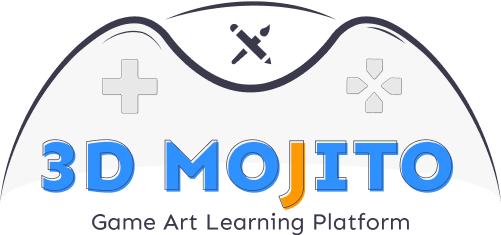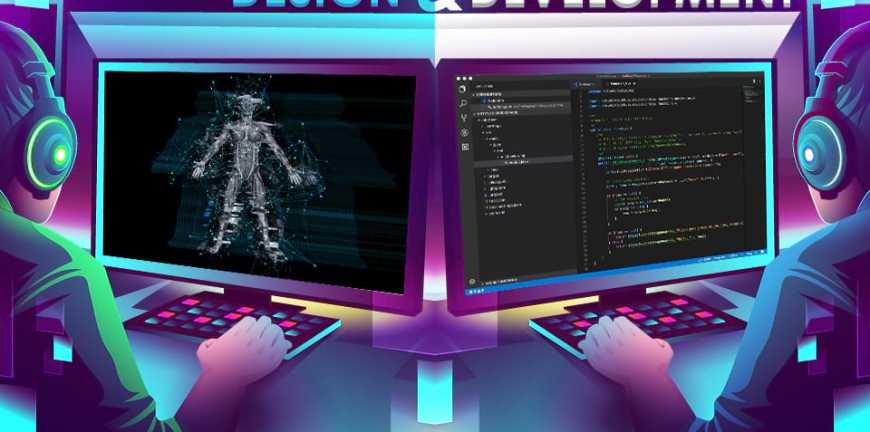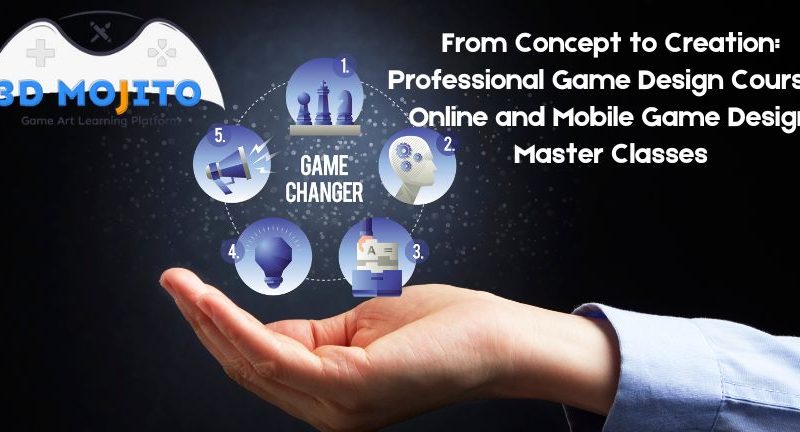In today’s rapidly evolving gaming industry, the demand for skilled professionals who can design and develop immersive games is at an all-time high. Whether you are an aspiring game designer or an experienced artist looking to refine your skills, enrolling in professional game design courses online and a Game art Level 2 course can significantly enhance your career prospects. These courses are designed to provide you with advanced knowledge and practical skills that are essential for creating compelling games that captivate audiences.
This article explores the benefits of pursuing professional game design courses online and the specific advantages of a Game art Level 2 course. We will discuss how these courses can help you advance your career, the key skills you’ll acquire, and how to choose the right program for your professional growth.
The Importance of Professional Game Design Courses Online

1. Flexibility and Accessibility
One of the most significant advantages of professional game design courses online is the flexibility they offer. Unlike traditional in-person classes, online courses allow you to learn at your own pace and schedule, making it easier to balance your studies with work or other commitments. This accessibility means that you can gain valuable skills from the comfort of your home, without the need to relocate or attend a physical institution.
Professional game design courses online are designed to accommodate learners of all levels, from beginners to advanced professionals. Whether you’re just starting in the industry or looking to specialize, online courses provide the flexibility you need to succeed.
2. Access to Industry-Standard Tools and Techniques
Enrolling in professional game design courses online provides you with the opportunity to learn using industry-standard software and tools. These courses often include hands-on training with popular programs such as Unity, Unreal Engine, Blender, and Autodesk Maya. Gaining proficiency in these tools is essential for creating high-quality games and is a skill set that employers highly value.
By completing professional game design courses online, you’ll gain practical experience with the same tools used by leading game development studios. This experience not only boosts your technical skills but also makes you more competitive in the job market.
3. Networking Opportunities
Online courses are not just about learning; they also provide valuable networking opportunities. Many professional game design courses online offer forums, group projects, and mentorship programs where you can connect with peers and industry professionals. Building these relationships can open doors to job opportunities, collaborations, and further professional development.
Networking through professional game design courses online allows you to connect with like-minded individuals and professionals who can offer guidance, support, and potential career opportunities.
4. Portfolio Development
A strong portfolio is crucial for anyone seeking to advance in the gaming industry. Professional game design courses online often include projects and assignments that contribute to your portfolio. These projects allow you to showcase your skills and creativity to potential employers. Whether it’s designing a game level, creating character models, or developing a game prototype, these courses help you build a portfolio that demonstrates your expertise.
Completing professional game design courses online ensures that you have a well-rounded portfolio that highlights your skills in various aspects of game design, making you a more attractive candidate to employers.
5. Specialization in Advanced Topics
As the gaming industry becomes more specialized, having advanced knowledge in specific areas can give you a competitive edge. A Game art Level 2 course is particularly beneficial for artists looking to refine their skills in creating detailed game environments, characters, and assets. This course focuses on advanced techniques that go beyond the basics, allowing you to create more polished and professional work.
Specializing through a Game art Level 2 course not only enhances your technical skills but also positions you as an expert in a specific area of game design, making you more valuable to employers and clients.
What to Expect from a Game Art Level 2 Course

A Game art Level 2 course is designed for individuals who have a foundational understanding of game art and want to take their skills to the next level. This course typically covers more complex and detailed aspects of game art creation, including advanced modeling, texturing, lighting, and rendering techniques.
1. Advanced 3D Modeling and Sculpting
One of the primary focuses of a Game art Level 2 course is advanced 3D modeling and sculpting. Students learn how to create highly detailed and realistic models, whether they’re working on characters, environments, or props. This includes mastering techniques such as high-poly to low-poly workflow, retopology, and creating optimized assets for real-time rendering.
By enrolling in a Game art Level 2 course, you’ll develop the ability to create intricate and highly detailed models that enhance the visual quality of your game projects.
2. Texturing and Shading
Advanced texturing and shading are critical components of a Game art Level 2 course. Students learn how to create and apply textures that bring depth and realism to their models. This includes using advanced techniques such as PBR (Physically Based Rendering) texturing, procedural textures, and creating custom shaders. Understanding how light interacts with different materials is key to producing realistic game art.
Through a Game art Level 2 course, you’ll gain expertise in texturing and shading, enabling you to produce visually stunning and realistic game assets that stand out.
3. Lighting and Rendering Techniques
Lighting plays a crucial role in setting the mood and atmosphere of a game. A Game art Level 2 course teaches advanced lighting and rendering techniques that can dramatically improve the visual impact of your game scenes. This includes working with real-time lighting in game engines, as well as pre-rendered lighting techniques for cinematics and promotional art.
Mastering lighting and rendering through a Game art Level 2 course allows you to create more immersive and visually striking game environments.
4. Character and Environment Design
A Game art Level 2 course often includes a focus on both character and environment design, helping students to create cohesive and engaging game worlds. This involves understanding the principles of design, composition, and storytelling, as well as the technical skills needed to bring these elements to life. Students learn how to create characters that are both visually appealing and narratively compelling, as well as environments that support the game’s story and gameplay.
The skills gained in a Game art Level 2 course ensure that your game designs are not only technically proficient but also artistically coherent and compelling.
5. Integration with Game Engines
A key aspect of a Game art Level 2 course is learning how to integrate your art into game engines like Unity or Unreal Engine. This includes importing assets, setting up materials and lighting, and optimizing performance for real-time rendering. Understanding how to work within the constraints of a game engine is crucial for creating art that not only looks good but also runs efficiently in the final game.
By completing a Game art Level 2 course, you’ll be able to seamlessly integrate your work into game engines, ensuring that your art is both visually impressive and technically sound.
How These Courses Can Advance Your Career

1. Enhancing Your Skill Set
Enrolling in professional game design courses online and a Game art Level 2 course allows you to acquire advanced skills that are highly sought after in the gaming industry. By enhancing your skill set, you make yourself more valuable to employers and clients, increasing your chances of landing high-profile projects or job opportunities.
Professional game design courses online provide you with the latest tools and techniques, while a Game art Level 2 course helps you refine and specialize your skills, making you a more competitive candidate in the job market.
2. Expanding Your Professional Network
The connections you make during professional game design courses online can be invaluable for your career. Whether it’s through group projects, mentorship programs, or online forums, these courses provide opportunities to connect with other professionals in the industry. Building a strong professional network can lead to job opportunities, collaborations, and ongoing professional development.
Networking through professional game design courses online can help you build relationships with industry professionals, opening doors to new career opportunities.
3. Building a Strong Portfolio
A well-crafted portfolio is essential for showcasing your skills and landing job opportunities. Professional game design courses online and a Game art Level 2 course provide you with the projects and assignments needed to build a comprehensive portfolio. By including a range of work that demonstrates your advanced skills, you can make a strong impression on potential employers and clients.
Completing professional game design courses online and a Game art Level 2 course ensures that your portfolio is diverse, well-rounded, and reflective of your advanced skill set.
4. Gaining Industry Recognition
By completing advanced courses, you position yourself as an expert in your field. This can lead to recognition within the industry, whether through awards, certifications, or invitations to speak at conferences and events. Professional game design courses online and a Game art Level 2 course provide you with the credentials needed to gain this recognition and advance your career.
Gaining recognition through professional game design courses online and a Game art Level 2 course can help you stand out in a competitive industry and lead to new career opportunities.
5. Increasing Your Earning Potential
As you acquire advanced skills and gain recognition in the industry, your earning potential increases. Employers and clients are willing to pay more for professionals who have proven expertise and can deliver high-quality work. By investing in professional game design courses online and a Game art Level 2 course, you are investing in your future earning potential.
Completing professional game design courses online and a Game art Level 2 course can lead to higher-paying job opportunities and increased income potential.
Choosing the Right Course for You
When selecting professional game design courses online or a Game art Level 2 course, it’s important to consider several factors:
-
Course Content:
- Ensure the course covers the advanced topics you’re interested in and provides hands-on training with industry-standard tools.
-
Instructor Expertise:
- Look for courses taught by experienced professionals who have a strong background in game design and development.
-
Student Support:
- Choose a course that offers mentorship, feedback, and support to help you refine your skills and achieve your goals.
-
Portfolio Development:
- Opt for a course that includes projects and assignments that contribute to your portfolio, showcasing your advanced skills.
-
Certification and Accreditation:
- Consider courses that offer certification or accreditation, which can enhance your resume and provide proof of your expertise.
Conclusion: Elevating Your Career in Game Design
Enrolling in professional game design courses online and a Game art Level 2 course is a strategic move for anyone looking to advance their career in the gaming industry. These courses provide you with the advanced skills, industry knowledge, and networking opportunities needed to succeed in this competitive field. By completing these courses, you’ll not only enhance your technical abilities but also position yourself as a leader in game design, opening doors to new career opportunities and increasing your earning potential. Whether you’re just starting or looking to specialize, investing in your education through these courses is a step toward a successful and rewarding career in game design.



